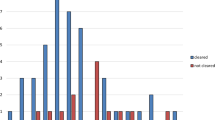Abstract
Objectives
We aimed to retrospectively review the efficiency of ureterorenoscopy (URS) applied without ureteral dilatation for evaluating pediatric ureteral pathologies.
Methods
The files of pediatric patients hospitalized in our clinic between January 2000 and June 2006 due to ureteral stone disease were reviewed and evaluated retrospectively. The ages, medical histories, physical examination results, preoperative routine blood and urinary tests, and culture results were recorded. Ureteral orifice dilatation was not needed in any of the patients. Due to the risk of mucosal trauma and edema development in the ureteral orifice and intramural ureter, 3F and 4F catheters were applied in all patients following the ureterenoscopy. These catheters were removed 24 h after the procedure.
Results
The files of 54 pediatric patients with a mean age of 8.5 years (range 1–16 years) were evaluated retrospectively. While diagnostic URS was applied in 12 (22.2%) of the patients, ureteral calculi were determined in 42 (77.8%) patients and the stones were fragmented by pneumatic lithotripter. Twenty-five of the stones were localized in the lower ureter, 16 in the mid-ureter, and 3 in upper ureter. The mean stone size was found to be 7.1 mm (range 4–12). None of the stones migrated to the proximal region. In 2 patients open ureterolithotomy was applied; stones were localized in the upper ureter in both of these patients.
Conclusions
Ureterorenoscopy can be successfully and safely applied without the need for ureteral dilatation in ureteral pathologies of children.
Similar content being viewed by others
References
Busaidy SS, Prem AR, Medhat M (1997) Pediatric ureteroscopy for ureteric calculi: a 4-year experience. Br J Urol 80:797–801
Choong S, Whitfield H, Duffy P, Kellett M, Cuckow P, Van’t Hoff W, Corry D (2000) The management of paediatric urolithiasis. BJU Int 86(7):857–860
Tan MO, Karaoglan U, Sozen S, Biri H, Deniz N, Bozkirli I (2006) Minimally invasive treatment of ureteral calculi in children. Urol Res 34:381–387
Lahme S (2006) Shockwave lithotripsy and endourological stone treatment in children. Urol Res 34(2):112–117
Hill DE, Segura JW, Patterson DE et al (1990) Ureteroscopy in children. J Urol 144:481–483
Defoor W, Dharamsi N, Smith P et al. (2005) Use of mobile extracorporeal shock wave lithotripter: experience in a pediatric institution. Urology 65:778–781
Minevich E, Defoor W, Reddy P et al (2005) Ureteroscopy is safe and effective in prepubertal children. J Urol 174:276–279; discussion 279
Reddy PP (2004) Pediatric ureteroscopy. Urol Clin North Am 31:145–156
Borgmann V, Nagel R (1982) Urolithiasis in childhood: a study of 181 cases. Urol Int 37:194–204
Shroff S, Watson GM (1995) Experience with ureteroscopy in children. Br J Urol 75(3):395–400
Jones BJ, Ryan PC, Lyons O, Grainger R, McDermott TE, Butler MR (1990) Use of the double pigtail stent in stone retrieval following unsuccessful ureteroscopy. Br J Urol 66(3):254–256
El-Assmy A, Hafez AT, Eraky I et al (2006) Safety and outcome of rigid ureteroscopy for management of ureteral calculi in children. J Endourol 20(4):252–255
Hubert KC, Palmer JS (2005) Passive dilation by ureteral stenting before ureteroscopy: eliminating the need for active dilation. J Urol 174(3):1079–1080
Soygur T, Zumrutbas AE, Gulpinar O, Suer E, Arikan N (2005) Hydrodilation of the ureteral orifice in children renders ureteroscopic access possible without any further active dilation. J Urol 176(1):285–287
Kurzrock EA, Huffman JL, Hardy BE, Fugelso P (1996) Endoscopic treatment of pediatric urolithiasis. J Pediatr Surg 31(10):1413–1416
Tana AH, Al-Omara M, Denstedt JD, Razvia H (2005) Ureteroscopy for pediatric urolithiasis: an evolving first-line therapy. Urology 65(1):153–156
Author information
Authors and Affiliations
Corresponding author
Rights and permissions
About this article
Cite this article
Gedik, A., Orgen, S., Akay, A.F. et al. Semi-rigid ureterorenoscopy in children without ureteral dilatation. Int Urol Nephrol 40, 11–14 (2008). https://doi.org/10.1007/s11255-007-9235-5
Received:
Accepted:
Published:
Issue Date:
DOI: https://doi.org/10.1007/s11255-007-9235-5




